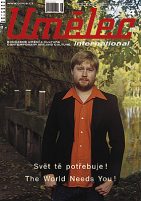| Umělec 2001/4 >> Fear Not the Fair | Просмотр всех номеров | ||||||||||||
|
|||||||||||||
Fear Not the FairUmělec 2001/401.04.2001 Ivan Mečl | news | en cs |
|||||||||||||
|
"A number of Czech art theorists and artists are still under the impression that art fairs amount to nothing but a brown stain on the list of international art happenings. The more pragmatic consider them a necessary evil; they will sometimes dare to visit one, but the tradition of contemptuously slamming fairs perseveres.
This is called the anxiety of reality and the panicky fear of looking into the mirror of contemporary art. Like it or not, art fairs show the visual, and content-bearing state of contemporary art and social self-reflection. Its culture, or the lack of it, its cleverness or stupidity, its calculation or naiveté all show through without the protecting hand of a curator. Simply put, it’s all just hanging naked and defenseless, spread out in front of you with huge, small or no economic talent. And it just has to go on. Denouncing the art business because it deals in spiritual substance is a unique characteristic of the Czech intellectual world. But contemporary society uses money, and has no other way of measuring the real, transferable and universal. We’ve all chosen such a society, and we can accept its values or ridicule them. But serious attack is the same as “fouling one’s own nest,” unless one is preparing for a revolution, which is the only goal that can justify such actions. Let’s assume that we’re not revolutionaries, but art theorists. Nevertheless we act like revolutionaries and claim that the art business is bad and hurts the arts. In serious debates we tell this to the artists; we warn them against the temptations of the market; we promise them a life lost in a labyrinth of grants, scholarships and exchange programs. In other words, the life of an artist gone mad from his or her own genius, measured by committees comprised of intellectuals with a similar fate. Frustrated by knowledge of this reality, the artist fears to say aloud that he or she would like to be represented by a commercial gallery and take part in art fairs. He or she would be glad to sell something in order to stop looking for other jobs and borrowing money; he or she would very much like to become economically independent. Because in fact the feeling of being economically independent nourishes spiritual independence. In order to prove that putting one’s work on the market is not a nefarious act, it is necessary to disprove a few superstitions. It is untrue that only bad and stupid art — art made for business — sells. Explaining that the contemporary art market is not bound by restrictive criteria preventing certain works or artists to enter the exchange is futile. If we insist on this superstition, we condemn all buyers and interested parties to play the role of ignorant fools manipulated by vicious and feeble-minded gallerists. We condemn them for being individuals that lack will and discernment, something we have practiced for so many years in special art schools. Are we not actually afraid that an unscholarly person might be able to evaluate a work of art by knowing and agreeing on its price? It is untrue that an art fair is depressing. This stems from a very personal feeling of fear in professionals who fail to understand it, the feeling of a vegetarian falling into a pot of lamb goulash — something that should happen once in a while, if only so that he knows exactly why he’s a vegetarian. It is untrue that nobody in the galleries is willing to talk to you if you’re not buying. The fact that you’re there means that maybe one day… when you manage to work out your opinions and stop wanting to be just given artworks for free… It is untrue that most gallerists at art fairs go for the surefire stuff and exhibit only proven works. On the contrary, some gallerists take significant risks by showing new names, many more than one would expect in such a situation. Some works do anticipate a progressive and sensitive buyer, it’s true, because there are those who care more about being close to a chosen work than amassing money. Ivan Mečl "
01.04.2001
Рекомендуемые статьи
|
|||||||||||||















Комментарии
Статья не была прокомментированаДобавить новый комментарий